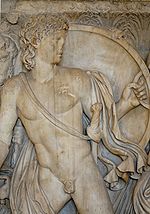
Heroic nudity
Encyclopedia


Classics
Classics is the branch of the Humanities comprising the languages, literature, philosophy, history, art, archaeology and other culture of the ancient Mediterranean world ; especially Ancient Greece and Ancient Rome during Classical Antiquity Classics (sometimes encompassing Classical Studies or...
to describe the use of nudity
Nudity
Nudity is the state of wearing no clothing. The wearing of clothing is exclusively a human characteristic. The amount of clothing worn depends on functional considerations and social considerations...
in classical sculpture
Sculpture
Sculpture is three-dimensional artwork created by shaping or combining hard materials—typically stone such as marble—or metal, glass, or wood. Softer materials can also be used, such as clay, textiles, plastics, polymers and softer metals...
to indicate that a sculpture's apparently mortal human subject is in fact a hero
Greek hero cult
Hero cults were one of the most distinctive features of ancient Greek religion. In Homeric Greek, "hero" refers to a man who was fighting on either side during the Trojan War...
or semi-divine being. This convention began in archaic
Archaic period in Greece
The Archaic period in Greece was a period of ancient Greek history that followed the Greek Dark Ages. This period saw the rise of the polis and the founding of colonies, as well as the first inklings of classical philosophy, theatre in the form of tragedies performed during Dionysia, and written...
and classical Greece
Ancient Greek sculpture
Ancient Greek sculpture is the sculpture of Ancient Greece. Modern scholarship identifies three major stages. They were used to depict the battles, mythology, and rulers of the land known as Ancient Greece.-Geometric:...
and was later adopted by Hellenistic and Roman sculpture
Roman sculpture
The study of ancient Roman sculpture is complicated by its relation to Greek sculpture. Many examples of even the most famous Greek sculptures, such as the Apollo Belvedere and Barberini Faun, are known only from Roman Imperial or Hellenistic "copies." At one time, this imitation was taken by art...
. This concept operated for women as well as for men, with females having themselves portrayed as Venus
Venus (mythology)
Venus is a Roman goddess principally associated with love, beauty, sex,sexual seduction and fertility, who played a key role in many Roman religious festivals and myths...
and other goddesses. Particularly in Roman examples like the Tivoli General or Delos "Pseudo-Athlete", this could lead to an odd juxtaposition of a hyper-realistic portrait bust in the Roman style (warts-and-all for the men, or with an elaborate hairstyle for the women) with an idealised god-like body in the Greek style.
As a concept, it has been modified since its inception, with other types of nudity now recognised in classical sculpture (eg the pathetic
Pathos
Pathos represents an appeal to the audience's emotions. Pathos is a communication technique used most often in rhetoric , and in literature, film and other narrative art....
nudity of brave but defeated barbarian enemies like the Dying Gaul
Dying Gaul
The Dying Gaul , formerly known as the Dying Gladiator, is an ancient Roman marble copy of a lost Hellenistic sculpture that is thought to have been executed in bronze, which was commissioned some time between 230 BC and 220 BC by Attalus I of Pergamon to celebrate his victory over the Celtic...
). Tonio Hölscher has even rejected the concept entirely for Greek art of the 4th century BC and earlier.
External links
- Jeffrey M. Hurwit, The Problem with Dexileos: Heroic and Other Nudities in Greek Art, American Journal of ArchaeologyAmerican Journal of ArchaeologyThe American Journal of Archaeology , the peer-reviewed journal of the Archaeological Institute of America, has been published since 1897...
- R.Osborne, Men Without Clothes: Heroic Nakedness and Greek Art, Gender & History, Volume 9, Number 3, November 1997 , pp. 504–528(25)
- Tom Stevenson, The 'Problem' with Nude Honorific Statuary and Portraits in Late Republican and Augustan Rome, Greece & Rome, 2nd Ser., Vol. 45, No. 1 (Apr., 1998), pp. 45–69.

